- Home »
- Insights »
- CIO View »
- Chart of the Week »
- Debtor’s prism
At least theoretically, how higher interest rates impact household spending for an economy as a whole is a surprisingly difficult question. After all, each interest payment by a debtor is also the income of some creditor, and ultimately benefits another household. Even at a micro level, the same household typically has both savings and borrowings.
In practice, applied economists tend to rely on rules of thumb. There are good reasons for this, as our Chart of the Week shows. In recent decades, rises in interest payments as percentage of household disposable income have typically been followed by recessions. After the sharp spike in interest rates over the past two years, that ratio is now approaching that typically signaled trouble ahead.
Household interest payments have spiked – will a recession once again follow?
 Sources: Haver Analytics, DWS Investment GmbH as of 11/24/23
Sources: Haver Analytics, DWS Investment GmbH as of 11/24/23
“Not so fast, though,” argues Christian Scherrmann, U.S. economist at DWS. “While we do continue to expect a soft patch in U.S., probably quite soon, the aggregate picture for U.S. household finances is not all that bad, at least not yet.” Labor markets are one key variable, already showing signs of moderation, with wage growth likely to cool further. That would add to pressure on low-income borrowers, a group which tends to rely more heavily on credit card debt and other forms of unsecured credit. Delinquency rates on credit cards, for example, have risen sharply, though they remain far below the levels seen before 2007, let alone during the subsequent Great Financial Crisis. At the same time, the volume of credit card loans is beginning to slow and volumes for car loans and other consumer loans are actually shrinking already.
This suggests that household behavior is already changing. While credit rationing may play some role for the least creditworthy would-be borrowers, households able to afford it are probably prioritizing repaying costly credit-card debts or car loans. Of course, all that too comes at the expense of aggregate consumption. Home equity withdrawal has become very costly indeed. And finally, in the U.S. as elsewhere, some sources of debt traps, especially among the least well-off, such overdue rents or utility bills, are tricky to track.
Of course, the main reason many wonks are uncertain about the immediate prospects is that the overall data on household financing still suffers from the pandemic in the form of excess savings from government largesse. When exactly these have or will run out, this is likely to matter less and less, given that the bulk (around 70% based on deposit statistics) are among the top 20% in household incomes. Less discussed, but perhaps just as relevant, are behavioral changes, not least because for many younger households also struggling with student debt, the recent spike in inflation and interest rates must have come like a particularly rude awakening, unlikely anything they previously experienced or budgeted for in terms of their financial planning.




